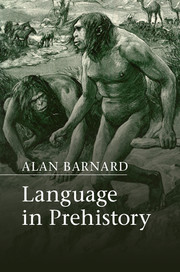Book contents
- Frontmatter
- Dedication
- Contents
- List of figures
- List of tables
- Preface
- 1 Introduction
- 2 Population diversity and language diversity
- 3 What did prehistoric people do?
- 4 How did prehistoric people think?
- 5 Narratives of the every-day
- 6 Mythological narratives
- 7 Sexual selection and language evolution
- 8 Conclusions and thoughts for the future
- Glossary
- References
- Index
5 - Narratives of the every-day
Published online by Cambridge University Press: 05 November 2015
- Frontmatter
- Dedication
- Contents
- List of figures
- List of tables
- Preface
- 1 Introduction
- 2 Population diversity and language diversity
- 3 What did prehistoric people do?
- 4 How did prehistoric people think?
- 5 Narratives of the every-day
- 6 Mythological narratives
- 7 Sexual selection and language evolution
- 8 Conclusions and thoughts for the future
- Glossary
- References
- Index
Summary
Narratives as most people use them, most of the time, include stories, descriptions of recent and long-ago past events, discussions of future plans, and so on. Through means such as these, humans have advanced their understanding of the world to a degree that would have been quite impossible without them.
In cognitive psychology, both experimental work (e.g., Morrison and Conway 2010) and theoretical studies (e.g., Nelson and Fivush 2004) have suggested a clear relation between the acquisition of vocabulary and the laying down of autobiographical memory. Both are necessary for individual cognitive development, which in turn creates a propensity for the co-evolution of language and cognition. In order for memory to exist, one must have words to describe things. These begin to proliferate at the age of about six months. In order to describe, one must have rules for doing so. In other words, one needs a grammar as well as a vocabulary. Grammar, and with it early memories, can appear by the age of three years. Morrison and Conway (2010: 23–4), among others, distinguish the age of acquisition of words from the age of encoding of those words, and, therefore, episodic memory from a slightly later development (a few months later), namely, autobiographical memory. The latter suggests what they call retrievability, the ability to remember the association between the word and what it represents: ‘the problem lies not in forming memories but in representing them in long-term memory in a way that renders them retrievable’ (2010: 23).
The answer to the problem of everyday communication among hunter-gatherers, I am afraid, does lie in some complicated arguments.
Language and thought
Much is dependent on communication with the ‘self’, but communication with others, in other words, talking, must also be implied. In other words, the evolution of language requires elements of both the former (as Chomsky 1986 would have it) and the latter (see Knight and Power 2012). Indeed, the usages here date only from the 1970s, and are open to revision and debate among psychologists. It has been argued that talking enabled, for example, the communication possible for humans to sail to Australia by 48,000 (or 60,000) years ago (see e.g., Davidson and Noble 1992). Sea-level changes (a fall of more than 100 metres) did mean that this was easier than it would be later, but even then, hopping from island to island was a difficult prospect.
- Type
- Chapter
- Information
- Language in Prehistory , pp. 73 - 91Publisher: Cambridge University PressPrint publication year: 2016



